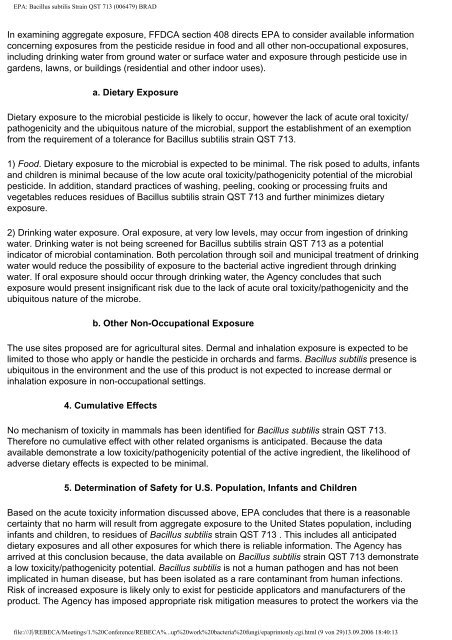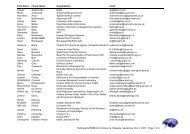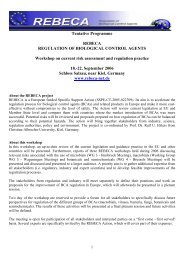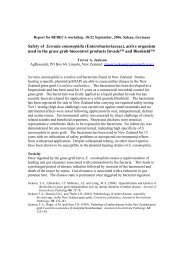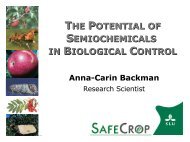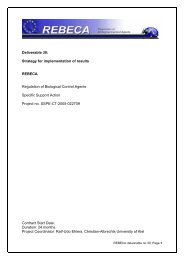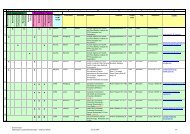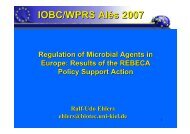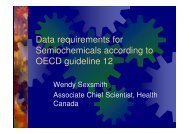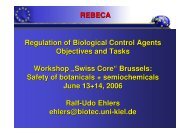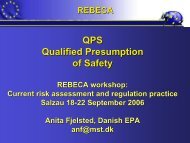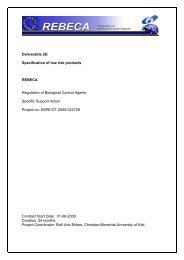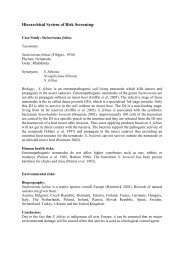EPA: Bacillus subtilis Strain QST 713 (006479) BRAD - REBECA
EPA: Bacillus subtilis Strain QST 713 (006479) BRAD - REBECA
EPA: Bacillus subtilis Strain QST 713 (006479) BRAD - REBECA
- No tags were found...
You also want an ePaper? Increase the reach of your titles
YUMPU automatically turns print PDFs into web optimized ePapers that Google loves.
<strong>EPA</strong>: <strong>Bacillus</strong> <strong>subtilis</strong> <strong>Strain</strong> <strong>QST</strong> <strong>713</strong> (<strong>006479</strong>) <strong>BRAD</strong>In examining aggregate exposure, FFDCA section 408 directs <strong>EPA</strong> to consider available informationconcerning exposures from the pesticide residue in food and all other non-occupational exposures,including drinking water from ground water or surface water and exposure through pesticide use ingardens, lawns, or buildings (residential and other indoor uses).a. Dietary ExposureDietary exposure to the microbial pesticide is likely to occur, however the lack of acute oral toxicity/pathogenicity and the ubiquitous nature of the microbial, support the establishment of an exemptionfrom the requirement of a tolerance for <strong>Bacillus</strong> <strong>subtilis</strong> strain <strong>QST</strong> <strong>713</strong>.1) Food. Dietary exposure to the microbial is expected to be minimal. The risk posed to adults, infantsand children is minimal because of the low acute oral toxicity/pathogenicity potential of the microbialpesticide. In addition, standard practices of washing, peeling, cooking or processing fruits andvegetables reduces residues of <strong>Bacillus</strong> <strong>subtilis</strong> strain <strong>QST</strong> <strong>713</strong> and further minimizes dietaryexposure.2) Drinking water exposure. Oral exposure, at very low levels, may occur from ingestion of drinkingwater. Drinking water is not being screened for <strong>Bacillus</strong> <strong>subtilis</strong> strain <strong>QST</strong> <strong>713</strong> as a potentialindicator of microbial contamination. Both percolation through soil and municipal treatment of drinkingwater would reduce the possibility of exposure to the bacterial active ingredient through drinkingwater. If oral exposure should occur through drinking water, the Agency concludes that suchexposure would present insignificant risk due to the lack of acute oral toxicity/pathogenicity and theubiquitous nature of the microbe.b. Other Non-Occupational ExposureThe use sites proposed are for agricultural sites. Dermal and inhalation exposure is expected to belimited to those who apply or handle the pesticide in orchards and farms. <strong>Bacillus</strong> <strong>subtilis</strong> presence isubiquitous in the environment and the use of this product is not expected to increase dermal orinhalation exposure in non-occupational settings.4. Cumulative EffectsNo mechanism of toxicity in mammals has been identified for <strong>Bacillus</strong> <strong>subtilis</strong> strain <strong>QST</strong> <strong>713</strong>.Therefore no cumulative effect with other related organisms is anticipated. Because the dataavailable demonstrate a low toxicity/pathogenicity potential of the active ingredient, the likelihood ofadverse dietary effects is expected to be minimal.5. Determination of Safety for U.S. Population, Infants and ChildrenBased on the acute toxicity information discussed above, <strong>EPA</strong> concludes that there is a reasonablecertainty that no harm will result from aggregate exposure to the United States population, includinginfants and children, to residues of <strong>Bacillus</strong> <strong>subtilis</strong> strain <strong>QST</strong> <strong>713</strong> . This includes all anticipateddietary exposures and all other exposures for which there is reliable information. The Agency hasarrived at this conclusion because, the data available on <strong>Bacillus</strong> <strong>subtilis</strong> strain <strong>QST</strong> <strong>713</strong> demonstratea low toxicity/pathogenicity potential. <strong>Bacillus</strong> <strong>subtilis</strong> is not a human pathogen and has not beenimplicated in human disease, but has been isolated as a rare contaminant from human infections.Risk of increased exposure is likely only to exist for pesticide applicators and manufacturers of theproduct. The Agency has imposed appropriate risk mitigation measures to protect the workers via thefile:///J|/<strong>REBECA</strong>/Meetings/1.%20Conference/<strong>REBECA</strong>%...up%20work%20bacteria%20fungi/epaprintonly.cgi.html (9 von 29)13.09.2006 18:40:13


